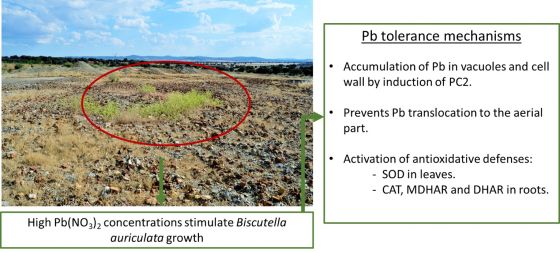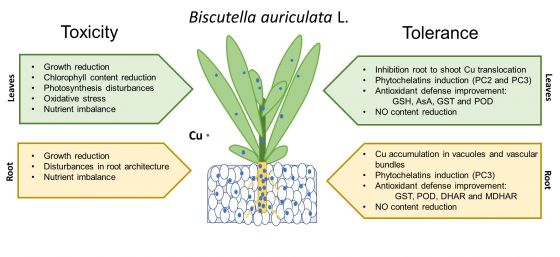PhD student at IGEA/UCLM/EEZ-CSIC - October 2016 / May 2021.
Deciphering heavy metal tolerance and accumulation strategies in a population of the plant species Biscutella auriculata L. from a mining area.
PhD student: Jesús D. Peco 1,2
Supervisor: Pablo León Higueras Higueras 2
Co-Supervisors: Juan A. Campos Gallego1, Luisa M. Sandalio González3.
1: ETSIA-UCLM, 2: IGEA-UCLM, 3: EEZ-CSIC
Large-scale mining of mineral resources is well known for its direct and indirect adverse effects on the environment, due to the deposition of large volumes of waste material. Even when the mining activities cease, the contamination of ecosystem continues due to the dispersion of heavy metals (HVs) from the abandoned mine to bordering lands (González-Corrochano et al., 2014). Phytoremediation and phytostabilization are a promising cost-effective and environmentally friendly strategies which would mitigate the dispersion of HVs and therefore, help to maintain the ecosystem health. Nevertheless, phytoremediation of HVs is still in experimental stage due to the difficulty of finding plant species that have the optimal characteristics for this purpose. In this way, one of the most important field in phytoremediation strategy is to look for plants that grow fast without toxic symptoms and have the capacity to take up HVs (Dickinson, 2016).
Biscutella auriculata L. is an annual herbaceous plant which is able to grow in a highly metal-contaminated area belonging to San Quintín mine located in Ciudad Real (South-Central Spain). The mechanisms involved in the HVs tolerance of this species have not been studied before. Therefore, this PhD focuses on researching: (i) the toxic effect of Cu, Cd and Pb in morphological and physiological parameters in this species; (ii) the effects of these HVs on nutrient status, as well as the accumulation mechanisms; and (iii) the enzymatic and non-enzymatic antioxidant system with have relevance in HVs tolerance. With all these results, we want to assess the possible use of B. auriculata in restoration techniques of HVs degraded areas.
Our findings show the ability of this species to develop strategies to efficiently accumulate and tolerate Cd, Cu and Pb. The main results are summarized in Figure 1 (Cd treatment), Figure 2 (Pb treatment) and Figure 3 (Cu treatment), which are the graphical abstracts belonging to the articles published so far.



References:
Dickinson, N., 2016. Phytoremediation. Encycl. Appl. Plant Sci. 3, 327–331. https://doi.org/10.1016/B978-0-12-394807-6.00016-2
González-Corrochano, B., Esbrí, J.M., Alonso-Azcárate, J., Martínez-Coronado, A., Jurado, V., Higueras, P., 2014. Environmental geochemistry of a highly polluted area: The La Union Pb-Zn mine (Castilla-La Mancha region, Spain). J. Geochemical Explor. 144, 345–354. https://doi.org/10.1016/j.gexplo.2014.02.014
Peco, J.D., Campos, J.A., Romero-Puertas, M.C., Olmedilla, A., Higueras, P., Sandalio, L.M., 2020a. Characterization of mechanisms involved in tolerance and accumulation of Cd in Biscutella auriculata L. Ecotoxicol. Environ. Saf. 201, 110784. https://doi.org/10.1016/j.ecoenv.2020.110784
Peco, J.D., Higueras, P., Campos, J.A., Olmedilla, A., Romero-Puertas, M.C., Sandalio, L.M., 2020b. Deciphering lead tolerance mechanisms in a population of the plant species Biscutella auriculata L. from a mining area: Accumulation strategies and antioxidant defenses. Chemosphere 261, 127721. https://doi.org/10.1016/j.chemosphere.2020.127721
Peco, J.D., Sandalio, L.M., Higueras, P., Olmedilla, A., Campos, J.A., 2020c. Characterization of the biochemical basis for copper homeostasis and tolerance in Biscutella auriculata L. Physiologia Plantarum (Accepted pending revision).
Jesús D. Peco – PhD student
I am PhD student in the program of Agricultural and Environmental Science in University of Castilla-La Mancha (Ciudad Real, Spain). My PhD research is a collaboration between IGEA-UCLM (Instituto de Geología Aplicada, UCLM, Almaden, Spain), ETSIA-UCLM (Escuela Técnica Superior de Ingenieros Agrónomos, UCLM, Ciudad Real, Spain) and EEZ-CSIC (Estación Experimental del Zaidín, Granada, Spain).
I am a biologist, graduated from the University of Alcalá (Madrid, Spain). Subsequently, I did a Master degree in Oenology, Viticulture and Wine Marketing from the University of Castilla-La Mancha (Spain). During these years, I focused my research on soil biological indicator, using these markers to evaluate the effect that a great variety of agricultural practices, pesticides, HVs… have on the soil biological activity and consequently, on soil quality.
Currently, my PhD is aimed at the phytoremediation of HVs in polluted soils. Carrying out a research about the main mechanisms of tolerance and accumulation against HVs in plants, as well as the identification of possible HVs-hyperaccumulator and hypertolerant plant species. However, during my doctoral thesis, I have continued to collaborate on several projects through the evaluation of soil quality using biological indicators.
In this way, my participation in AUREOLE project is aimed to assess the biological aspects in antimony contaminated soils, in the proximity of decommissioned mines of this element.


